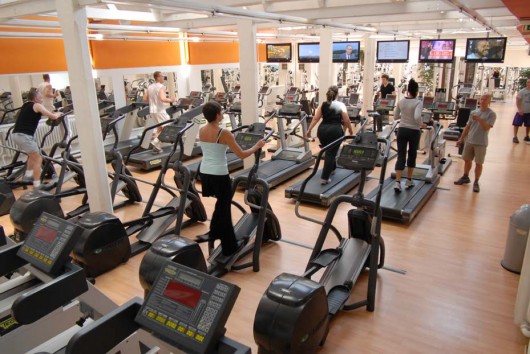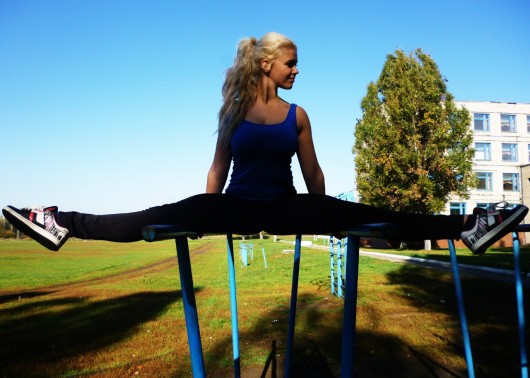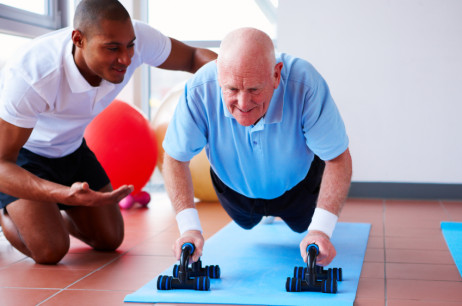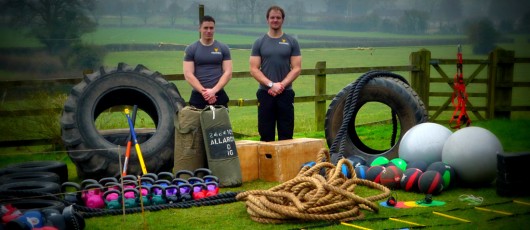 Fitness means being able to perform physical activity. Fitness and ‘getting fit’ is a way of life and a commitment to yourself, your body, and your future health. Being physically fit is so much more than being able to lift some heavy weights or complete a 10k run. You don’t have to be an super-athlete to be fit – with the proper motivation and commitment, anyone can do it!
Fitness means being able to perform physical activity. Fitness and ‘getting fit’ is a way of life and a commitment to yourself, your body, and your future health. Being physically fit is so much more than being able to lift some heavy weights or complete a 10k run. You don’t have to be an super-athlete to be fit – with the proper motivation and commitment, anyone can do it!
It is important to have a good fitness level, as it improves your general health as well as your quality of life. Fitness is comprised of cardiovascular exercise, muscular strength and endurance, flexibility, and and body composition. Ensuring that these four areas are at optimum levels will make you a stronger, healthier individual.
[/spoiler]Fitness can be divided into two categories: general fitness (health and well-being) and specific fitness (your performance ability in a specific sport or activity).
Categories of Fitness
Fitness is less about the actual activity that you do, and more about the time and intensity you put into the activity. Because of these variations, there are many different ways to measure someone’s fitness levels.
Length of fitness training and intensity can help gauge how fit you are, but typically there are four main headings to categorize fitness:
• Cardiovascular health
• Weight training (Muscular strength and endurance)
• Flexibility
• Body composition
Cardio is all about the body’s circulation and respiration and how it uses energy to fuel physical performance. It helps reduce body fat, which is great for those wanting to get fit and also lose some stubborn pounds! Your heart is a muscle and needs exercise just as much as muscles like biceps or hamstrings. Speed-walking, cycling or swimming are great exercises for cardio fitness, especially when performed at a strenuous enough level to make it aerobic (when you get breathless and sweaty).
 Muscular strength is the strength or force created by working the muscles against either gravity or different weights (both are types of resistance). Muscular endurance is about exerting muscle function for long periods of time without fatigue. Many people, especially women, are intimidated by weight training, thinking it will make them look too bulky or that they will have bad form (technique). But weight training makes a huge difference to overall fitness levels, helping burn calories, tone, strengthen your core (the muscles around the spine) and improve balance. It really does work for everything! Typically, you should aim for 3 sets of 10 to 12 reps and a rest period after each set, which will contribute to your overall fitness plans.
Muscular strength is the strength or force created by working the muscles against either gravity or different weights (both are types of resistance). Muscular endurance is about exerting muscle function for long periods of time without fatigue. Many people, especially women, are intimidated by weight training, thinking it will make them look too bulky or that they will have bad form (technique). But weight training makes a huge difference to overall fitness levels, helping burn calories, tone, strengthen your core (the muscles around the spine) and improve balance. It really does work for everything! Typically, you should aim for 3 sets of 10 to 12 reps and a rest period after each set, which will contribute to your overall fitness plans.
 Flexibility is the range of motion around a joint. Stretching is a crucial part of any workout regime, but it is often overlooked. Good flexibility in the joints can help prevent injuries, loosen and lengthen muscles and improve general movement of the body. In today’s society, we live a much more sedentary lifestyle than in the past. Many of us work over computers and movement is limited. Stretching and improving flexibility will improve movement and aid fitness levels. If you want to improve your flexibility, try activities like yoga or extended.
Flexibility is the range of motion around a joint. Stretching is a crucial part of any workout regime, but it is often overlooked. Good flexibility in the joints can help prevent injuries, loosen and lengthen muscles and improve general movement of the body. In today’s society, we live a much more sedentary lifestyle than in the past. Many of us work over computers and movement is limited. Stretching and improving flexibility will improve movement and aid fitness levels. If you want to improve your flexibility, try activities like yoga or extended.
 Body composition is the makeup of the body: muscle, fat, bone, etc. and how much of each there are. Do not rely solely on scales to give you an accurate or fair idea of your fitness progress. The scales do not have all the answers. They do not tell you how much body weight is fat and how much is muscle etc. Muscle is absolutely fine and actually weighs more than fat – making you ‘heavier’ on the scales. There are a number of available tests to measure body fat, BMI, cholesterol and fitness levels.
Body composition is the makeup of the body: muscle, fat, bone, etc. and how much of each there are. Do not rely solely on scales to give you an accurate or fair idea of your fitness progress. The scales do not have all the answers. They do not tell you how much body weight is fat and how much is muscle etc. Muscle is absolutely fine and actually weighs more than fat – making you ‘heavier’ on the scales. There are a number of available tests to measure body fat, BMI, cholesterol and fitness levels.
Exercise has been shown to have a number of health benefits, including lowering blood pressure and blood cholesterol levels, strengthening bones and joints, and aiding in weight loss. Partaking in physical activity can reduce your risk of chronic disease, improve your balance and coordination, and help your overall personality by improving your confidence, self-esteem, and mood. A good overall fitness level can improve your quality of sleep, sharpen your mind, and help you handle stressful situations better. All positive news!
Fitness Is For All
 Fitness is open and accessible to all ages and levels. Physical fitness is a lifestyle and a habit, generally achieved through correct nutrition, exercise, hygiene and rest. It is advisable to check with your doctor before setting out on a new fitness regimen but otherwise if you’re new to the world of fitness, there’s no time like the present – give it a go!
Fitness is open and accessible to all ages and levels. Physical fitness is a lifestyle and a habit, generally achieved through correct nutrition, exercise, hygiene and rest. It is advisable to check with your doctor before setting out on a new fitness regimen but otherwise if you’re new to the world of fitness, there’s no time like the present – give it a go!
First off, a balanced fitness plan is crucial to success. A healthy adult should introduce both aerobic exercise (such as running) and strength training (weights) into a plan, for a total body workout and balanced health routine.
A balanced, active fitness plan will not only help during workouts, but in aspects of everyday life as well. A person with a good fitness level will be burning more calories even when resting. Those who exercise and have good overall fitness are perfoming in the optimum conditions for their body, which means that even during rest, they are functioning more efficiently than somebody who does no physical activity and is unfit.
Everyone is different and so are fitness goals, lifestyles, preferences, and personal barriers. Careful planning, perhaps with the help of a health professional, can be the first step to introducing small changes into your lifestyle which can make big fitness improvements to your body, mind, and longevity. Remember that there are no barriers to fitness when it comes to age or mobility. A child needs a lot of exercise and an older person will benefit from good fitness levels, to help fight off infections and illness. There are also a number of ways that people with a disability can remain fit. The aim is fit for all, fit for life.
Fitness is not about being thin or having visible abs. It is a combination of qualities that enable us to fulfil our potential when performing vigorous physical activities. It is more than just the aesthetics; fitness considers the performance of the heart, lungs, and muscles of the body, as well as our mental and emotional wellbeing and development.
Surprisingly, physical fitness and good health do not necessarily go hand in hand. Somebody who has good health or looks slim may still be unfit if they do not perform enough exercise. Physically fit people can perform everyday tasks and jobs with ease.
 People often speak about ‘functional fitness.’ Functional fitness means getting the balance right between strength, stamina, flexibility and endurance. Being fit in this way improves your quality of life, and makes you more prepared for the aches and pains your body decides to throw at you. If you have a good, balanced fitness level – simple tasks like catching a bus or picking up heavy carrier bags will be easier … and so will life in general!
People often speak about ‘functional fitness.’ Functional fitness means getting the balance right between strength, stamina, flexibility and endurance. Being fit in this way improves your quality of life, and makes you more prepared for the aches and pains your body decides to throw at you. If you have a good, balanced fitness level – simple tasks like catching a bus or picking up heavy carrier bags will be easier … and so will life in general!



